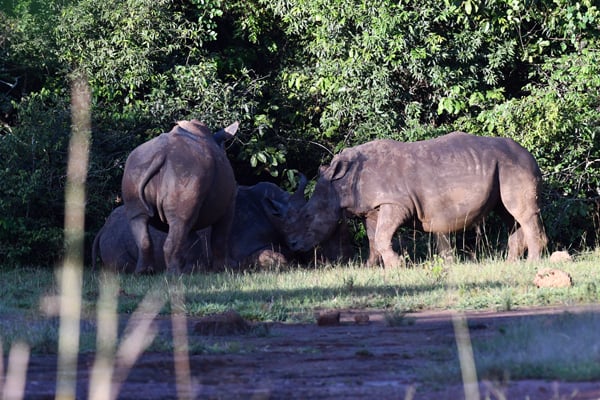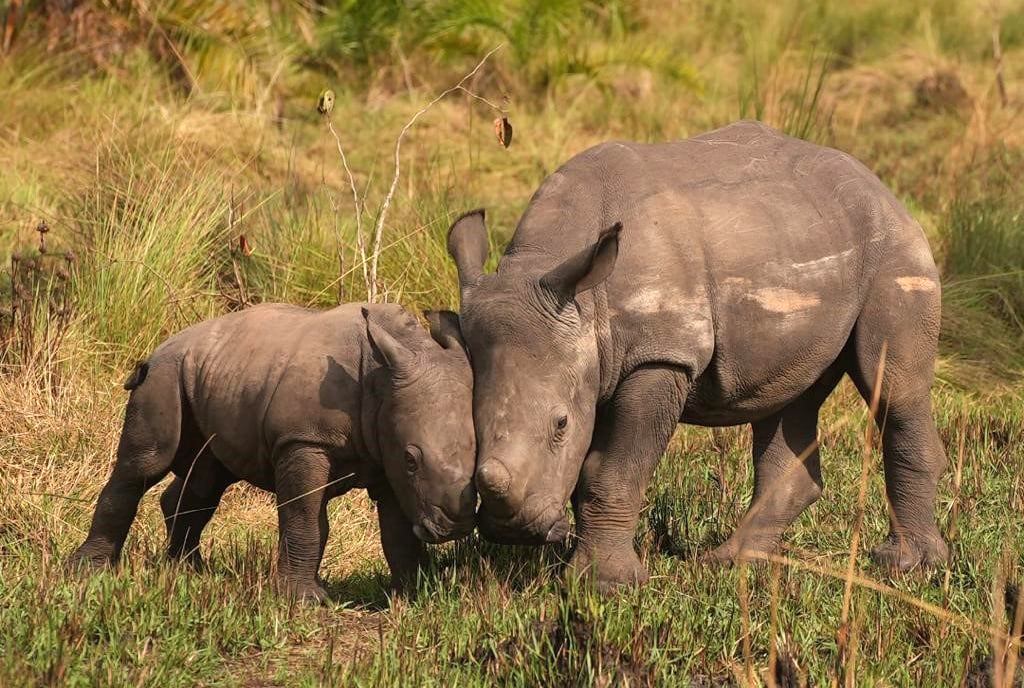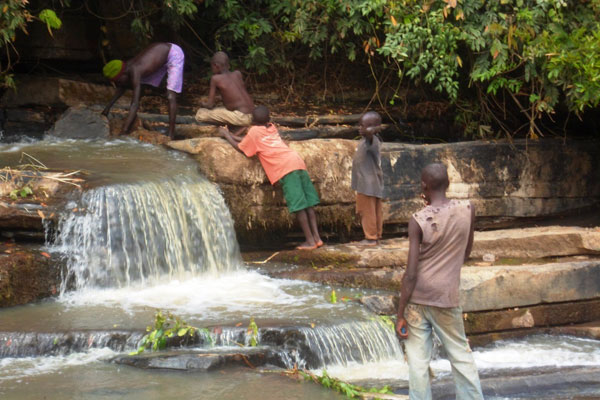How cash, unmet promises closed Zziwa Rhino Sanctuary

Some of the rhinos at Zziwa Rhino Sanctuary in Nakasongola District before they were relocated by Uganda Wildlife Authority. Photo/Edgar R. Batte
What you need to know:
- A rhinoceros, commonly abbreviated to rhino, is a member of any of the five extant species of odd-toed ungulates in the family Rhinocerotidae, as well as any of the numerous extinct species therein.
- A grown up male rhino weighs three tonnes (3000kgs), whereas a female weighs 2.8 tonnes (2,800kgs). At birth, a rhino weighs between 45 and 50kgs.
- Female rhinos produce between 10 and 12 babies and start producing at four years. On the other hand, males become sexually active at 10 years.
Those who seek to stop a dogfight, the Basoga say, must first remove the skin over which they are fighting.
That must have been at the back of the minds of the people at the Uganda Wildlife Authority (UWA), when it revoked the wildlife use rights permit it had earlier granted Rhino Fund Uganda (RFU) for the management of rhinos at Zziwa Rhino Sanctuary in Nakasongola District.
Writing on behalf of the executive director of UWA on January 21, when UWA gave Rhino Fund Uganda notice of intention to revoke the permit within two weeks, Mr John Makombo, indicated that it was all about the safety of the rhinos.
“In order to ensure the security and safety of the rhinos and in accordance with Section 45 of the Uganda Wildlife Act, 2019, this is to notify RFU that UWA will proceed to revoke the wildlife use rights permit granted to RFU unless RFU guarantees legal possession and availability of the land on which the rhinos are…” Mr Makombo writes.
Mr Makombo’s letter came amid signs that RFU was not about to resolve its long-standing wrangles with Capt Joseph Charles Roy, the proprietor of the land on which the sanctuary sits.
“I have never gotten a penny from my land. In 2017, things changed. I said to myself, I have got land. I could do a lot with this land, but we have rhinos on it and I should start earning from it after 18 years. So I gave instructions to my lawyers to give them a notice as per our contract,” Cap Roy says.
Omongole and Co Advocates obliged. On October 16, 2017, they wrote putting RFU on notice.
“As you are well aware, Rhino Fund Uganda Ltd entered into an agreement to grant a licence with our clients Zziwa Ranchers Ltd and Capt Joseph Charles Roy. In the said agreement, it was stated that the licensor [Zziwa Ranchers Ltd/Capt Charles Roy] would grant part of its 62sq km of land comprised in leasehold and mailo titles to the licensee, which is the Rhino Fund Uganda,” the letter addressed to Ms Angie Genade, the then executive director of RFU, reads.
On January 28, 2019, the lawyers penned another letter in which they demanded that RFU vacates two houses, including one occupied by the executive director, two double rooms occupied by volunteers and a store block.
“As per the concession agreement, the properties that Rhino Fund Uganda occupies were not part of the agreement and were not to be occupied by yourselves. This is to notify yourselves to give vacant possession of the properties.”
The RFU did not take the notice lying down. They filed a suit in the High Court, accusing Capt Roy of breaching an agreement that he had entered with RFU on August 20, 2002, in which he committed to availing RFU his land to run a sanctuary “for a period of 30 years and subject to review every 10 years during the said term.” The agreement would have lapsed in 2032.
Museveni intervenes
RFU ran to the President, asking him to buy the land from Capt Roy, but he had not yet put it up for sale.
Mr Musveni then chose to hold mediation talks with the two parties. Two meetings were held at State House Entebbe. The second meeting, held on October 30, 2019, was aimed at finding ways of resolving the impasse and paving way for working together.
Mr Museveni advised that all parties withdraw all suits that they had filed in the courts.
He also advised RFU to reconstitute and expand the board to have nine members and accommodate representatives of both government and Capt Roy’s Zziwa Rhino and Wildlife Ranch (ZRWR). Zziwa Ranchers was to have three representatives, RFU (3) and government (2). But the RFU team rejected the deal, saying it needed to have a bigger number on the board.
“They said they needed to have more people on the board because of funding and issues to do with donors. We then accepted they have four, Zziwa (3), Ministry of Tourism (1), and UWA (1),” Capt Roy told this publication.

The signpost leading to Zziwa Rhino Sanctuary in Nakasongola District. Photo/Edgar R. Batte
Mr Museveni also directed that that RFU works to ensure Capt Roy starts earning from his land.
The meeting agreed the finer details would be worked out at subsequent meetings mediated by the Tourism ministry, UWA and State House.
On September 18, the parties signed a memorandum of understanding (MoU) in the presence of a State House legal officer, Ms Florence Kiconco.
The MoU revoked the 2002 agreement, but agreed to continue using the land for conservation purposes. They, however, made provisions for a review of the agreement every five years.
Fresh disagreements
Whereas the two parties agreed on reconstituting the board in line with the advice of President Museveni, disagreements soon cropped up over a new constitution, with Capt Roy’s side accusing RFU of drafting it without consulting them.
“RFU, well knowing the constitution to be amended was to govern the activities of the reconstituted board comprising ZRWR members and RFU members, acted unilaterally and in utmost bad faith, without involvement of ZRWR and created a repugnant document that does not meet the spirit and letter of the MoU,” Omongole and Company Advocates wrote in a January 18 letter to the executive director of RFU.
Capt Roy argues that the biggest problem has been the failure by RFU to stick to decisions arrived at in the meetings.
He says six sessions of the talks were brokered by UWA.
“In each meeting, we would agree on certain things, but they would turn around and change everything. They were not committed to working together,” Capt Roy says.
The biggest disagreement that finally led to the closure of the rhino sanctuary last month and the taking over of the management of the rhinos by UWA was centred on money.
The MoU had provided that Capt Roy and his Zziwa Ranchers would be entitled to 20 per cent of all revenue generated at the sanctuary, except for donations. But Capt Roy demanded that he had to first look into the sanctuary’s books of accounts.
That demand was based on Minute 05/04(a) of the fourth mediation meeting on the implementation of the MoU.
The minute provided that “RFU shall avail audited books of accounts on the operations of the sanctuary for the last five years to ZRWR”.
RFU, in an April 1 letter signed by the board chairperson, Mr Vincent Opyene, and addressed to ZRWR and copied to Mr John Makombo, set conditions that ZRWR had to meet before it would be allowed to access the books of accounts.
“Upon further consultations with other key stakeholders, we have been advised to inform you that RFU will avail you with the above reports upon taking up your positions on the Board of Directors and after execution of a confidentiality clause as per our policy,” the letter reads in part.
Capt Roy justifies his demand to first examine the books of accounts for due diligence, but Mr Opyene says the demand was not in the spirit of the MoU.
“The MoU did not say first do due diligence before you come (on the board). If it had been put in the MoU, we would have allowed him (to access the books of accounts), but that was not the position of the MoU,” Mr Opyene says.
Mr Opyene says RFU’s books of accounts are meant to be confidential documents. Besides, he says, RFU was not sure what it was that Capt Roy and his team wanted to do with the figures.
According to an urgent appeal for funds that it recently posted on its website, RFU receives most of its annual budget of $1m (about Shs3.6b) from tourism revenue.
It was not possible to establish how much RFU has been receiving as donations, but it has previously been the recipients of some plump sums from, among others, the European Union (EU), which facilitated the construction of an electric fence around the 26sq mile sanctuary.
This has led to suspicions that the real reason as to why it would not want to make the books of accounts open to public scrutiny would be to avoid revealing the extent of the funding that it has been receiving. Capt Roy is inclined to believe that kind of thinking.
“We had heard stories that they were getting money and writing it down as donations. That exempts you from taxes, but now we can never know,” Capt Roy says.
So is there something that RFU is hiding? That is not a subject that Mr Opyene would want to discuss.
“We are already out of his land. We do not have anything to keep discussing that this was this,” he says.
It is, however, worth noting that it was that single decision not to avail those books of accounts that led ZRWR to jump out of the talks.
“Our clients are, therefore, past the mediation process and do not wish to continue with the MoU…Our clients will not be involved in any further talks, discussions, mediation processes or activities with RFU and demand that they leave their land immediately,” an April 7 letter from ZRWR’s lawyers states.
That set the stage for the closure of the sanctuary to visitors. The question now is what will happen to the 33 rhinos? Are they to be relocated to the game parks from where they were hunted and made extinct in the 1980s? That is the question, at least for now.

A ranger interacts with a rhino at the sanctuary. PHOTO/COURTESY
Tracing story of rhinos in Uganda
Uganda was once home to thousands of rhinos, but by 1960s, the numbers had reduced to only 400 eastern black rhinos and 300 Northern white rhinos.
During years of civil unrest in the 1970s and early 1980s, the remaining rhinos were poached to extinction with the northern white rhino last seen in 1982 in Murchison Falls NP, while the last eastern black rhino was last seen in Kidepo Valley National Park in 1983.
Originally, natives from West Nile and government took a deliberate move to translocate the northern white rhinos to Murchison Falls National Park, south of River Nile.
In 1924, an article appeared in Bulletin of the Zoological Society of New York that drew attention to the danger of extinction of the northern white rhino, forcing immediate action in Uganda to preserve the country’s population.
A census was carried out, which revealed about 150 individuals mainly in the area along the left bank of the Albert Nile, especially near swamps and marshy areas. The rhino population reduced to 130 by 1926.
Sanctuaries were designated, including Mt Kei Forest Reserve, Mt Otze Forest Reserve, and Aiya River Sanctuary in 1938 to protect the rhinos.
By 1939, the population had increased to 220 in West Nile and West Madi areas. By 1948, the numbers dropped to 190; 125 in West Madi and 65 in West Nile, where the rhinos had finally left the vicinity of Rhino Camp due to the invasion of their habitat by increasing native settlement.
By 1951, the total rhino population in West Nile was estimated to be 300 or so animals, and in 1955, to be some 350 animals with the main concentration in the area of Palorinya, Itula, Lumunga and Kali.
Reintroduction
Government, in conjunction with Rhino Fund Uganda, started a programme to reintroduce rhinos in the late 1990s.
They were reintroduced in phases, with two southern white rhinos brought to the Uganda Wildlife Education Conservation Centre on December 8, 2001. The two sub-adult southern white rhinos - a male and a female, were imported into the country from the Solio Game Reserve in central Kenya.
Under phase two, four rhinos named Taleo, Moja, Bella, and Kori were imported from Salio Ranch in Kenya and taken to Ziwa Rhino Sanctuary, located in Nakasongola, 138km away from Kampala.
In August 2006, two more southern white rhinos, Hassani and Nandi, a brother and sister, arrived from the USA as a donation from Disney’s Animal Kingdom. Nandi had her first calf on June 25, 2009, 16 months after mating with Taleo, making it the first birth of a rhino in Uganda in the last 28 years.
From the initial six rhinos taken to the sanctuary, the number has since risen to 33, making the Ugandan rhinos the fastest in reproduction globally.
On average, rhinos produce after every five years, but the ones in Ziwa, on average, produce after every two years.

Rhinos are under Appendix I of the Convention on International Trade in Endangered Species of Wild Fauna and Flora. All animals under Appendix I are critically endangered species and no one is allowed to trade in them or any of their parts.
About rhinos
A rhinoceros, commonly abbreviated to rhino, is a member of any of the five extant species of odd-toed ungulates in the family Rhinocerotidae, as well as any of the numerous extinct species therein. Two of the extant species are native to Africa, and three to Southern Asia
A grown up male rhino weighs three tonnes (3000kgs), whereas a female weighs 2.8 tonnes (2,800kgs). At birth, a rhino weighs between 45 and 50kgs. A rhino is the second largest mammal after the elephant that stands at about seven tonnes (7,000kgs). It has a lifespan of 45 years.
Female rhinos produce between 10 and 12 babies and start producing at four years. On the other hand, males become sexually active at 10 years. They delay because they need time to prioritise on how to man their territories. Rhinos move in a group (crash) of twos or threes; one mother and one calf. When a mother gives birth, the old calf is expected to leave.




